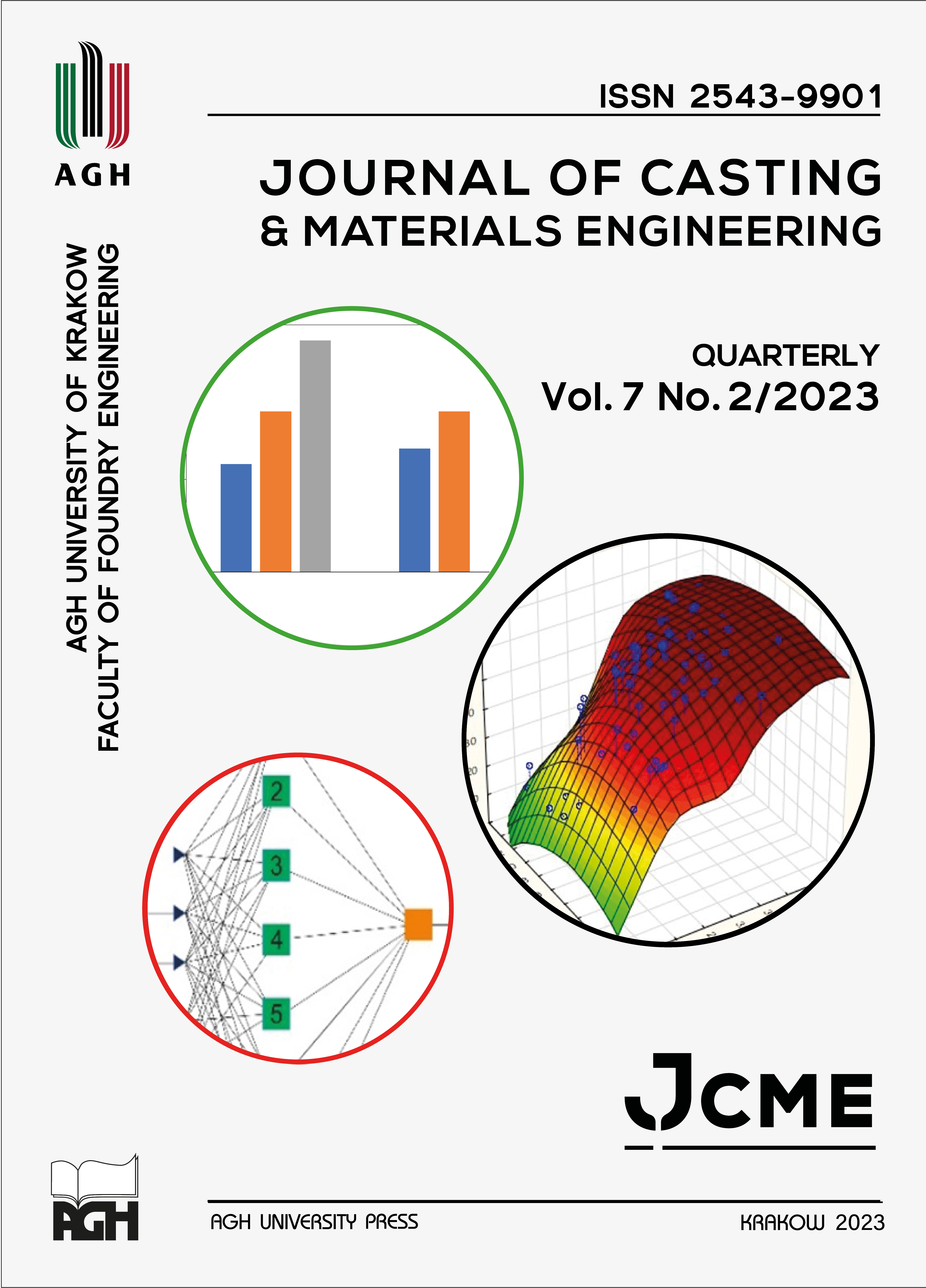Artificial Neural Networks as a Tool for Supporting a Moulding Sand Control System Based on the Dependency between Selected Moulding Sand Properties
DOI:
https://doi.org/10.7494/jcme.2023.7.2.15Abstract
The article presents the potential for using artificial neural networks to support decisions related to the rebonding of green moulding sand. The basic properties of the moulding sand tested in foundries are discussed, especially compactibility as it gives the most information about the quality of green moulding sand. First, the data that can predict the compactibility value without the need for testing are defined. Next, a method for constructing an artificial neural network is presented and the network model which produced the best results is analysed. Additionally, two applications were designed to allow the investigation results to be searchable by determining the range of values of the moulding sand parameters.
Downloads
References
Michta-Stawiarska T. (1998). Difficulties in stabilizing the properties of classical green sand. Solidification of Metals and Alloys, 35(1), 9–13.
Lewandowski J.L. (1997). Tworzywa na formy odlewnicze. Kraków: Wydawnictwo AKAPIT.
Chang Y. & Hocheng H. (2001). The flowability of bentonite bonded green molding sand. Journal of Materials Processing Technology, 113(1–3), 238–244. Doi: https://doi.org/10.1016/S0924-0136(01)00639-2.
Moayyedian M., Abhary K. & Marian R. (2018). Optimization of injection molding process based on fuzzy quality evaluation and Taguchi experimental design. CIRP Journal of Manufacturing Science and Technology, 21, 150–160. Doi: https://doi.org/10.1016/j.cirpj.2017.12.001.
Parappagoudar M.B., Pratihar D.K. & Datta G.L. (2007). Non-linear modelling using central composite design to predict green sand mould properties. Proceedings of the Institution of Mechanical Engineers, Part B: Journal of Engineering Manufacture, 221(5), 881–895. Doi: https://doi.org/10.1243/09544054JEM696.
Ihom A.P., Ogbodo J.N., Allen A.M., Nwonye E.I. & Ilochionwu C. (2014). Analysis and prediction of green permeability values in sand moulds using multiple linear regression model. African Journal of Engineering Research, 2(1), 8–13.
Stauder B.J., Kerber H. & Schumacher P. (2016). Foundry sand core property assessment by 3-point bending test evaluation. Journal of Materials Processing Technology, 237, 188–196. Doi: https://doi.org/10.1016/j.jmatprotec.2016.06.010.
Manickam R. (2016). Back propagation neural network for prediction of some shell moulding parameters. Periodica Polytechnica Mechanical Engineering, 60(4), 203–208. Doi: https://doi.org/10.3311/PPme.8684.
Surekha B., Kaushik L.K., Panduy A.K., Vundavilli P.R. & Parappagoudar M.B. (2012). Multi-objective optimization of green sand mould system using evolutionary algorithms. The International Journal of Advanced Manufacturing Technology, 58, 9–17. Doi: https://doi.org/10.1007/s00170-011-3365-8.
Sahoo P.K., Pattnaik S. & Sutar M.K. (2020). Parametric Optimization of Permeability of Green Sand Mould Using ANN and ANFIS Methods. In: Li L., Pratihar D.K., Chakrabarty S., Mishra P.C. (Eds.), Advances in Materials and Manufacturing Engineering. Proceedings of ICAMME 2019. Springer, Singapore, 495–501. Doi: https://doi.org/10.1007/978-981-15-1307-7_56.
Chavan T.K. & Nanjundaswamy H.M. (2013). Effect of variation of different additives on green sand mold properties for olivine sand. International Journal of Research in Engineering & Advanced Technology, 1(4), 1–4.
Tompos A., Margitfalvi J.L., Tfirst E. & Héberger K. (2007). Predictive performance of “highly complex” artificial neural networks. Applied Catalysis A: General, 324(1), 90–93. Doi: https://doi.org/10.1016/j.apcata.2007.02.052.
Nielsen M.A. (2015). Neural networks and deep learning, vol. 25. San Francisco, CA: Determination Press.
Magalhaes B.R.C., Sterling T., Hines M. & Schurmann F. (2019). Fully-Asynchronous Cache-Efficient Simulation of Detailed Neural Networks. In: Rodrigues J., Cardoso J.S., Monteiro J., Lam R., Krzhizhanovskaya V.V., Lees M.H., Dongarra J.J., Sloot P.M.A. (Eds.) Computational Science – ICCS 2019. 19th International Conference, Faro, Portugal, June 12–14, 2019, Proceedings, Part III, vol. 11538. Springer, Cham. Doi: https://doi.org/10.1007/978-3-030-22744-9 33.
Tadeusiewicz R. (2015). Neural networks in mining sciences – general overview and some representative examples. Archives of Mining Sciences, 60(4), 971–984. Doi: https://doi.org/10.1515/amsc-2015-0064.
Jakubski J., Malinowski P., Dobosz S.M. & Major-Gabryś K. (2013). ANN modelling for the analysis of the green moulding sands properties. Archives of Metallurgy and Materials, 58(3), 961–963. Doi: https://doi.org/10.2478/amm-2013-0110.
Regulski K., Jakubski J., Opaliński A., Brzeziński M. & Głowacki M. (2010). The prediction of moulding sand moisture content based on the knowledge acquired by data mining techniques. Archives of Metallurgy and Materials, 61(3), 1709–1714. Doi: https://doi.org/10.1515/amm-2016-0277.
Jakubski J. & Dobosz S.M. (2010). The usage of data mining tools for green moulding sands quality control. Archives of Metallurgy and Materials, 55(3), 843–849.
Downloads
Published
Issue
Section
License
Copyright (c) 2023 Barbara Mrzygłód, Jarosław Jakubski, Andrzej Opaliński, Krzysztof Regulski

This work is licensed under a Creative Commons Attribution 4.0 International License.


